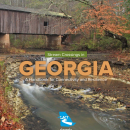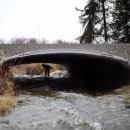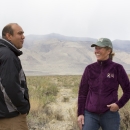Why are stream crossings important?
Few people consider the effects of culverts, utility crossings, and other infrastructure on the quality of stream habitat. Stream conditions may be quite different upstream and downstream of a stream road crossing, and may look different during low or high water. The design and condition of a stream crossing determine whether a stream behaves naturally and whether animals can migrate along the stream corridor.
Fortunately, we have learned how to design stream crossings that allow wildlife unrestricted access to a watershed, maintain natural stream conditions, and help protect roads and property from some of the damaging effects of floods.
The southeastern United States boasts many miles of streams and rivers and an extraordinary diversity of fish and wildlife. Yet, despite the abundance of streams and fish, the southeast has one of the highest fish and wildlife imperilment rates in the world due, in part, to barriers in fish and wildlife passage that can fragment their habitat. To address this, natural resource agencies have worked closely with the Army Corps of Engineers to develop and implement regulations that are intended to improve the safe passage of fish and wildlife.
Related Article: Fish Passage Restores Rivers, Protects Wildlife, and Rebuilds Economies
Can wildlife safely pass through the culverts in your neighborhood?
Wildlife need to move upstream and downstream safely so that they may access coldwater habitat, breed, access high quality food resources, and recolonize previously impacted habitats. Of the 70,000 miles of streams and rivers in Georgia, nearly all have habitat that are affected by culverts. So, how do you know if the culvert in your neighborhood is passable by fish? It can depend on the condition of the culvert and the size and a fish's swimming ability. One method occasionally used as a screening tool for fish passage fish passage
Fish passage is the ability of fish or other aquatic species to move freely throughout their life to find food, reproduce, and complete their natural migration cycles. Millions of barriers to fish passage across the country are fragmenting habitat and leading to species declines. The U.S. Fish and Wildlife Service's National Fish Passage Program is working to reconnect watersheds to benefit both wildlife and people.
Learn more about fish passage is the Filter method, adapted from the US Forest Service and thesis work conducted by Seth Coffman.
Related Article: What is Fish Passage?
Should a culvert be retrofitted or replaced?
Most stream crossings in Georgia were designed and installed at a time when the environmental impacts of such crossings were not understood. Even effective but aging crossings may need to be upgraded or replaced because they have weathered decades of floods and erosion. Upgrading bridges, culverts, and roads is required to keep our transportation networks safe and effective.
Repairing or replacing deteriorating culverts is not always as straightforward as installing a larger pipe. Some crossings need to be removed or retrofitted to facilitate the passage of aquatic and terrestrial wildlife. With tens of thousands of crossings in nearly every southeastern state, our agency and other partners are evaluating and prioritizing crossings that will help increase habitat connectivity for imperiled species of concern. This initiative incorporates our understanding of species distribution, channel morphology, and the potential importance of a culvert, dam, or impoundment in the context of the watershed’s natural connectivity.
Related Article: Get Involved with the National Fish Passage Program
The Georgia Stream Crossing Handbook
The Georgia Stream Crossing Handbook is for general audiences, including consultants, county engineers, back-hoe operators, students, and regulators, and outlines the importance of stream continuity for aquatic and terrestrial wildlife and highlights examples of wildlife passable and impassable crossings in Georgia. Regulations are also reviewed in general terms, and examples are provided to illustrate the intent of the regulations as of this publication date. This publication does not supersede any publication or regulations produced by the Army Corps of Engineers.
We hope that sharing this handbook will help prevent future species declines and ensure recreational opportunities in Georgia's streams for generations to come.
Federal Interagency Fish Passage Portal
The portal is a “one-stop shop” for anyone who needs information, funding, or resources to improve fish passage and aquatic connectivity projects. We provide landowners and public lands managers the tools to find funding across the federal government, as well as access to data, planning, and geospatial information.
The Bipartisan Infrastructure Law Bipartisan Infrastructure Law
The Bipartisan Infrastructure Law (BIL) is a once-in-a-generation investment in the nation’s infrastructure and economic competitiveness. We were directly appropriated $455 million over five years in BIL funds for programs related to the President’s America the Beautiful initiative.
Learn more about Bipartisan Infrastructure Law (BIL) provided multiple agencies with nearly $2 billion for aquatic and ecosystem restoration that supports fish passage. The BIL will fund projects over five years (FY2022 - FY2026) and result in a transformational impact to aquatic species, their habitats, and the surrounding communities.





